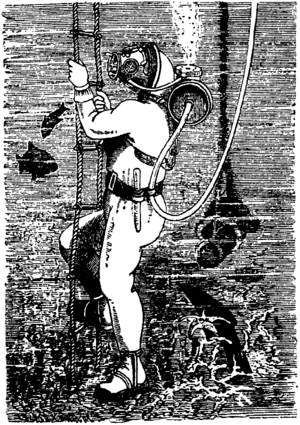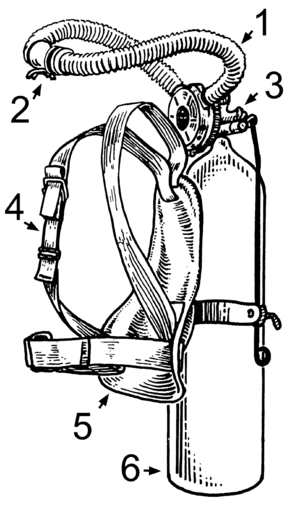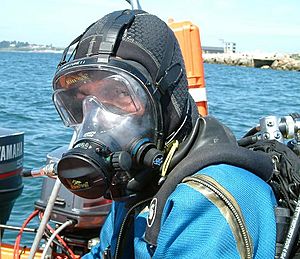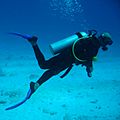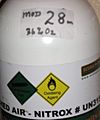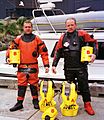Scuba diving facts for kids
Scuba diving is an exciting sport. It lets people swim underwater for a long time. Divers use a special tank filled with air. This tank is usually made of strong metal like steel or aluminum.
The word "scuba" is actually an acronym. It stands for Self-Contained Underwater Breathing Apparatus.
Contents
How Scuba Diving Started

People have wanted to explore underwater for a long time. In the 1600s, they used a "diving bell." This was like a big upside-down bucket lowered into the water. Air was trapped inside it. Divers could swim in and out of the bell to breathe. But the air would quickly get bad.
Later, heavy diving suits were invented. These suits had a hose connected to an air pump on land. Divers could walk on the seafloor. But it was hard to move around without getting tangled.
A famous Frenchman named Jacques Cousteau helped make scuba diving much better. He created a special device called a regulator. This regulator gave divers air only when they breathed in. This meant divers could use less air. It also made the equipment lighter. Divers could now swim freely with fins. Cousteau also made many underwater movies. He showed people the amazing world under the sea. He also taught them why it needed protection.
What Scuba Divers Use
Scuba divers use several important pieces of equipment. These items help them breathe, see, and move safely underwater.
- Air Tank: This is a metal cylinder that holds compressed air. Most dives use regular air. But for very deep dives, special air with more oxygen is used. This helps divers avoid a problem called "the bends." The bends can be painful or dangerous if a diver comes up too fast.
- BCD (Buoyancy Control Device): This is like a vest that the diver wears. It helps the diver float or sink. Divers can add air to it to float up. They can let air out to sink down. Divers also wear weights to help them stay at a certain depth.
- Regulator: This device connects to the air tank. It lowers the high pressure of the air from the tank. It makes the air easy to breathe at any depth.
- Gauges: Divers use a depth gauge to know how deep they are. An air gauge shows how much air is left in their tank. Other gauges or computers help divers stay safe. They track how long and deep the diver has been. They also remember how long it's been since the last dive.
Divers also use other gear. They wear a mask to see clearly underwater. Fins on their feet help them swim faster. A wetsuit keeps them warm. Water makes a person cold much faster than air does.
Getting Certified to Dive
Scuba diving can be risky if you don't know what you're doing. Running out of air or getting the bends is dangerous. So, you must take a special class to become a certified diver. This class teaches you how to use the equipment. It also teaches you how to dive safely.
PADI (Professional Association of Diving Instructors) is a big organization that certifies divers. There are many other groups too. Some vacation spots offer quick courses. You can get certified and do a shallow dive all in one day.
There are also advanced classes for special types of diving. These include diving around shipwrecks or in caves. Deep diving (more than 60 feet or 18 meters) also needs special training.
Interesting Scuba Facts
- People have explored less than 10% of the world's ocean floor. There's so much more to see!
- Through a dive mask, things look about 33% bigger. This is because of the flat lens.
- Sound travels much faster underwater than in the air. This means you can hear sounds from far away.
- The oldest male scuba diver was William Lambert from the USA. He was 100 years old when he dove!
- Many people fear sharks when thinking about diving. But coconuts actually kill more people each year than sharks do.
- A broken toe is the most common injury for scuba divers.
- Scuba diving is quite safe. Only about one person dies for every 211,864 dives.
- The deepest scuba dive ever recorded was 1,090 feet (332 meters).
- It's important to swim up slowly when returning to the surface. This lets the nitrogen in your blood safely dissolve.
Related pages
- Free diving - diving without scuba gear (holding your breath). Snorkeling gear is often used. No certification is needed.
Images for kids
-
The undersea kelp forest off of California
-
Diver looking at a shipwreck in the Caribbean Sea.
-
Diver wearing a dry suit in a cold lake in Finland
-
Diver under the Salt Pier in Bonaire
-
Diver taking photos of a shark
-
Divers touring a World War II shipwreck
-
US Navy SEAL divers train in 2019



